NOTES
Tuesday, July 10, 2007
06:43
Same old summer sky: white, still, quiet, other than hammers banging and heavy equipment whirring at the HSU Sports Complex—will construction ever end?
Birds:
1. mrgo (Mr. Go) chases Rusty Bill
2. junvenile unbanded
3. mlbob (Mrs. Go)
4. Rusty Bill
5. Shopper
6. mwob (Bow) flies northwest--missing tail feathers
7. mwrg (Wringer)
8. mwlblb (Tame Bird)
9. morlb (Red Eye)
10. mgrr (Droopy)
11. mrgw leg mites
Notes:
There’s a pair of ravens lurking this morning. They were perched on a tree I suspect may have had a nest, and have been flying around the house in big circles, squawking loudly. They are early morning and evening intruders, rarely seen or heard in the middle of the day.
The juvenile bird is still learning to open peanuts. He tried to harvest the nut from a half-opened shell, gave up, and tried another. He clutched the nut with only one foot, wrapped his spindly toes around it, while the other foot stayed free, maintaining his balance. He struggled to pierce the shell with his bill, lacking the strength and coordination of an adult. The Sibley Guide to Bird Life and Behavior says corvids (the bird family to which jays belong) hit an object only with their lower bill: “The New World jays have a special flange on the lower jaw that braces it against the skull and makes it a more effective chisel” (411).
I work to observe this specialized adaptation in action. Adult jays use their toes and bills with amazing dexterity. They wedge their food in a two-footed vise, clamp it securely with three anterior-facing toes and one posterior. In this position, they lower their bill and begin tapping. Deftly, they remove a nut from its shell, balance one half next to them, and chip away at the other half until it has splintered into pieces small enough to eat. I can see now, what appears to be an unconscious response to the environment has been learned through trial and error. The juveniles can barely use one foot to hold their shell in place, and peck lightly. They try to bite the nut, open-jawed--which serves only to catapult it forward, out of reach. With persistence, they successfully open the nut, and swallow the half whole—a move that makes my gullet ache to watch. As time goes on, they increase their control and maneuverability, taking time to chisel the half-peanut into reasonably bite-sized pieces.
The juveniles are still learning what is food. I watched an unbanded juvenile pick up bits of lichen, moss, and leaves placing each gingerly on a branch in front of him--a delicate earth sculpture that would go unnoticed unless you happened to be there during its construction. They peck and play, experimenting, getting to know and understand their world, in the same way a one-year-old toddles around, placing everything she sees in her mouth.
Same old summer sky: white, still, quiet, other than hammers banging and heavy equipment whirring at the HSU Sports Complex—will construction ever end?
Birds:
1. mrgo (Mr. Go) chases Rusty Bill
2. junvenile unbanded
3. mlbob (Mrs. Go)
4. Rusty Bill
5. Shopper
6. mwob (Bow) flies northwest--missing tail feathers
7. mwrg (Wringer)
8. mwlblb (Tame Bird)
9. morlb (Red Eye)
10. mgrr (Droopy)
11. mrgw leg mites
Notes:
There’s a pair of ravens lurking this morning. They were perched on a tree I suspect may have had a nest, and have been flying around the house in big circles, squawking loudly. They are early morning and evening intruders, rarely seen or heard in the middle of the day.
The juvenile bird is still learning to open peanuts. He tried to harvest the nut from a half-opened shell, gave up, and tried another. He clutched the nut with only one foot, wrapped his spindly toes around it, while the other foot stayed free, maintaining his balance. He struggled to pierce the shell with his bill, lacking the strength and coordination of an adult. The Sibley Guide to Bird Life and Behavior says corvids (the bird family to which jays belong) hit an object only with their lower bill: “The New World jays have a special flange on the lower jaw that braces it against the skull and makes it a more effective chisel” (411).
I work to observe this specialized adaptation in action. Adult jays use their toes and bills with amazing dexterity. They wedge their food in a two-footed vise, clamp it securely with three anterior-facing toes and one posterior. In this position, they lower their bill and begin tapping. Deftly, they remove a nut from its shell, balance one half next to them, and chip away at the other half until it has splintered into pieces small enough to eat. I can see now, what appears to be an unconscious response to the environment has been learned through trial and error. The juveniles can barely use one foot to hold their shell in place, and peck lightly. They try to bite the nut, open-jawed--which serves only to catapult it forward, out of reach. With persistence, they successfully open the nut, and swallow the half whole—a move that makes my gullet ache to watch. As time goes on, they increase their control and maneuverability, taking time to chisel the half-peanut into reasonably bite-sized pieces.
The juveniles are still learning what is food. I watched an unbanded juvenile pick up bits of lichen, moss, and leaves placing each gingerly on a branch in front of him--a delicate earth sculpture that would go unnoticed unless you happened to be there during its construction. They peck and play, experimenting, getting to know and understand their world, in the same way a one-year-old toddles around, placing everything she sees in her mouth.
Subscribe to:
Post Comments (Atom)
Pia Sets the Trap

07/24/07
Peaking...

07/24/07
Oops, wrong bird!

Demonstrating the "hold"
Try Again

Bird in the Bag
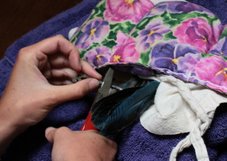
Applying a metal band
Measuring

and more measuring. . . .
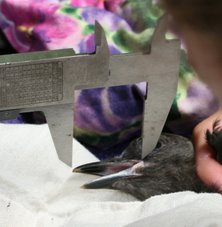
Blood Sampling

Jeff J's Work

Pia's test tube holder
Weighing
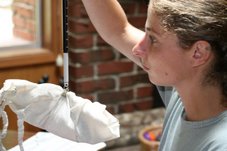
And then....release
When the sun goes down...

Steller's Jay Taxonomy/Description
Common Name: Steller's Jay
Class: Aves
Order: Passeriformes
Family: Corvidae
Genus: Cyanocitta
Species: Cyanocitta stelleri
Steller’s jay belongs to the family, Corvidae, in the Avian Order Passeriformes. Passeriformes is the order of perching birds. Corvidae is the jay, magpie and crow family. The Steller's jay's scientific name is Cyanocitta stelleri. The generic name, cyanocitta, means "blue jay". Its specific name, stelleri, named for George W. Steller (1709-1746). Steller was a German zoologist who explored the coastal areas of the northern Pacific Ocean in 1740.
Band Colors
black | white | purple | red | orangeBands are read in the following order:
light blue and light blue | green
Note: Light blue is difficult to read. It darkens with age, resembling a green band. (b/w/p/r/o/lb/g)
right bottom band
right top band
left bottom band
left top band
Data Collecting
This information was copied from the website of Dr. Jeff Black, Humboldt State University Wildlife Department.
The data to include for each record:
- Bird’s color code
- Size of social group seen at the same time
- Associates’ color codes (or if unbanded = UNB; or not determined = NOTD)
- Number of times associates came within 3 meters of each other
- Approximate time spent within 3 meter distance (e.g. 2 seconds, 15 sec, etc.)
- Total time you watched the birds (e.g. 5 minutes, 10 min, etc.)
- Time of day; start of observation (e.g. 1935)
- Date (e.g. 9.30.99)
- Location of observation (e.g. Rewood Bowl SW corner west bleachers. And state whether the bird was seen at a birdfeeder or in trees, etc)
- Comments (e.g. deformed leg, feather tuft on back, etc.)
Arcata Steller's Jay Sightings
Mr. Go










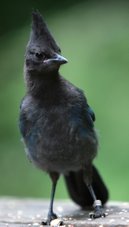










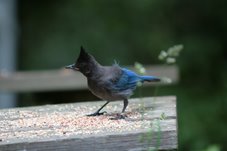











1 comment:
The photos with the peanuts are wonderful. It's good to see as well as read about the birds' actions.
Post a Comment